CURRENT KNOWLEDGE and SIGNICANCE
of CORONARY ARTERY ECTASIA
Using multiple indirect observations
and current understanding of endothelium-derived relaxation
factor, a possible etiology that implicates overstimulation
of endogenous nitric oxide is provided.
Current literature suggests that
ectatic coronary arteries, even without the presence of coronary
stenosis, are subject to thrombus formation, vasospasm, and
spontaneous dissection.
Newer subgroups of ectasia are
arising with the use of multiple interventional devices to dilate
coronary artery stenosis. By design, these destroy the media
of the coronary artery, and it is not clear whether these "iatrogenic"
ectatic arteries are subject to the same complications as "idiopathic"
coronary artery ectasia.
Further investigation is necessary
to help define the benefit of the proposed treatment regimen,
to clarify the prognosis of these newer groups of "iatrogenic"
ectasia, and to confirm or disprove the hypothesis targeting
nitric oxide as an etiologic factor.
Summary: Coronary artery
ectasia is the abnormal enlargement of the coronary artery.
The prognosis, treatment, and etiology of this disease remain
an enigma. There is some evidence to suggest that the incidence
of ectasia is increasing, and therefore understanding of this
entity needs to improve.
Vincent L. Sorrell, M.D., Michael
J. Davis, M.D., Alfred A. Bove, M.D., Ph.D.
January 20, 1996 issue of The Lancet.
Coronary
Ectasia: Prevalence, Clinical and Angiographic Characteristics
S Lahiri, KK Sethi, R Jain, JPS
Sawhney, VK Chopra,
S Dhawan, PK Khanna
Sir Ganga Ram Hospital, New Delhi
Coronary artery ectasia is a
well-recognized pathological finding. The clinical significance
of coronary ectasia is not clear. It has been suggested that
the presence of ectasia alone is as important as coronary artery
stenosis.
Over a study period of 3 years
and 3 months (Jan 1999–Mar 2002), 3571 patients underwent
coronary angiography in our institute.
Of these, 84 patients (2.3%),
70 males (83.8%) and 14 females (16.2%), met the criteria of
coronary artery ectasia, diagnosed as a segment of the artery
more than 1.5 times the diameter of the adjacent normal segment.
Fifty patients had ectasia without
any significant narrowing of other coronary arteries (isolated
ectasia) and 34 (40.4%) had associated significant coronary
artery stenoses. The mean age of the group was 54.4+8.6 years.
Hypertension was the most common
risk factor [46 (54.7%)], followed by diabetes [29 (34.5%)];
17 (20.2%) were smokers, 15 (17.8%) were dyslipidemic and 3
(3.5%) had a family history of premature coronary artery disease.
While 46 patients (54.7%) presented
with acute coronary syndrome [24 (28.5%) AMI and 22 (26.1%)
unstable angina], 9 (10.7%) had stable angina, 26 (30.9%) had
atypical chest pain and 3 (3.5%) had angina equivalent.
ECG revealed typical infarct
pattern in 24 patients (28.5%), ST/T changes in 29 (34.5%),
LBBB in 2 (2.3%), RBBB in 3 (3.5%) and normal pattern in 26
patients (30.9%).
The right coronary artery was
the vessel most commonly affected [53 (63%)] followed by the
left anterior descending [43 (51.1%)] and circumflex [24 (28.5%)]
artery. Left main coronary artery ectasia was seen in 7 (8.3%)
patients; 43 patients had single-vessel ectasia, 26 had two-vessel
and 15 had three-vessel ectasia.
A thrombus in the ectatic segment
was found in 13 patients, of whom 10 had acute coronary syndrome.
In patients presenting with acute
coronary syndrome, the culprit lesion was found to be related
to the ectatic segment in 67.4% of the patients based on ECG
correlation.
Overall, 34% of the patients
with isolated ectasia had definite acute coronary syndrome.
In the other 66% of patients,
it was an incidental finding on coronary angiography.
Three patients underwent PTCA
and 5 had CABG. In-hospital death was seen in 1 (1.1%) patient
with coronary ectasia and acute anterior myocardial infarction
with cardiogenic shock.
On follow-up of 22+13 months,
of 70 patients there was 1 (1.4%) sudden cardiac death while
5 (7.1%) continued with atypical chest pain.
Thus, coronary ectasia occurs
predominantly in males, and most often is an isolated finding.
It may present as acute coronary syndrome. However, the long-term
prognosis is good.
Summary:
Coronary artery ectasia
is the abnormal enlargement of the coronary artery. The prognosis,
treatment, and etiology of this disease remain an enigma. There
is some evidence to suggest that the incidence of ectasia is
increasing, and therefore understanding of this entity needs
to improve.
EXCERPTS FROM ARTICLE BELOW
LIPOPROTEIN
METABOLISM and ATHEROSCLEROSIS
FAMILIAL
HYPERCHOLESTEROLEMIA
Among the 18 homozygotes 9 patients
died.Eight of the 9 patients died of atherosclerotic cardiovascular
disease, and one patient died of leukemia.
| Table
2 @ Causes of death in heterozygous FH patients |
| Cause
of death |
No |
Age (yrs) |
Cholesterol
(mg/dl) |
Triglycer
|
@ |
| M |
F |
M |
F |
M |
F |
M |
F |
| CHD |
51 |
31 |
59}14 |
70}8 |
350}73 |
351}64 |
145}53 |
155}79 |
| Stroke |
4 |
8 |
64}5 |
71}4 |
365}143 |
345}66 |
130}72 |
151}66 |
| Cancer |
10 |
5 |
61}9 |
63}13 |
345}66 |
366}88 |
192}96 |
167}35 |
| Others |
6 |
8 |
64}18 |
72}10 |
315}89 |
361}84 |
132}53 |
148}78 |
| Total |
71 |
52 |
60}13 |
70}8 |
348}73 |
353}76 |
151}62 |
154}72 |
Table 2
| Table 1. Causes of
death in homozygous FH patients |
| No |
Case |
Sex |
Age |
Cause
of Death |
Cholesterol |
Triglyceride |
| (yr) |
(mg/dl) |
(mg/dl) |
| 1 |
KY |
F |
27 |
Sudden death |
609 |
126 |
| 2 |
KM |
F |
42 |
Sudden death |
610 |
180 |
| 3 |
SS |
F |
29 |
Sudden death |
1004 |
784 |
| 4 |
YE |
M |
11 |
Heart failure |
908 |
300 |
| 5 |
ST |
M |
18 |
Heart failure |
781 |
189 |
| 6 |
MI |
F |
23 |
Sudden death |
730 |
273 |
| 7 |
TT |
M |
57 |
Sudden death |
558 |
388 |
| 8 |
MK |
F |
50 |
Leukemia |
550 |
143 |
| 9 |
NY |
F |
38 |
Sudden death |
590 |
93 |
| Mean |
@ @
@ @ |
33 |
@ @ |
704 |
275 |
| SD |
15 |
164 |
213 |
Table 1
Clinical Features in FH
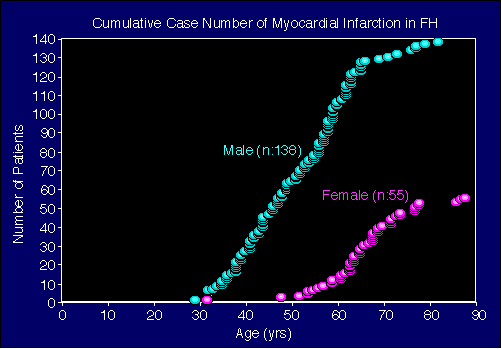
caect-Figure 1
Cumulative number of fatal
and non-fatal myocardial infarction in male and female FH patients
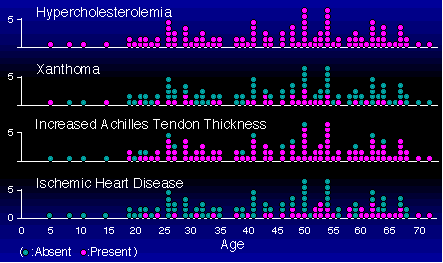
caect-Figure 2
Prevalence of clinical manifestations
at different ages in the heterozygotes
Coronary
angiographic studies have been done in homozygous and heterozygous
FH patients.
A 23-year-old man with homozygous
FH (M.T.) was found to have coronary ectasia by coronary angiography
(caect-fig3.gif) , which was also frequently (18%) observed
in heterozygous FH patients.
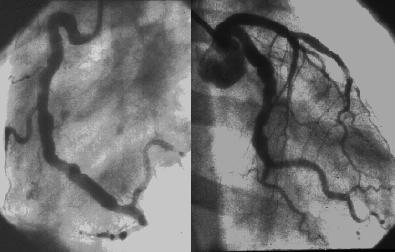
caect-Figure 3
One heterozygous FH patient (S.N.)
with coronary ectasia died of myocardial infarction, whose autopsy
findings showed severe coronary ectasia (2.7cm of coronary diameter)
with narrowing of the lumen (caect-Figure 4 and caect-Figure
5).
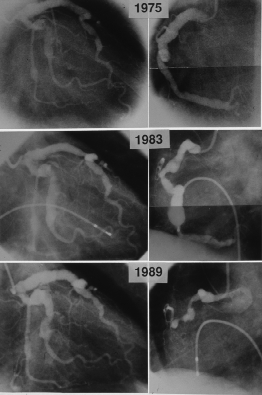
caect-Figure 4
Progression of coronary ectasia
in a patient with heterozygous FH .
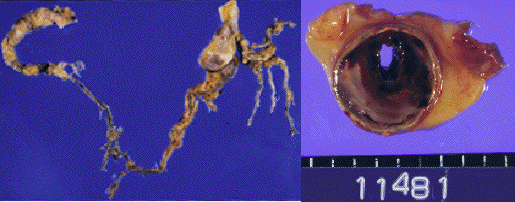 caect-Figure
5
caect-Figure
5
Coronary arteries obtained
from autopsy sample. Diameter of coronary ectasia is 2.7mm.
Five homozygotes and 105 male heterozygotes
and 56 female heterozygotes were studied by coronary angiography.
Coronary stenosis index (CSI) was obtained by assigning score
(0 to 5) to each of 15 coronary artery segments (caect-fig6.gif).
According to the regression equations between age and CSI, coronary
stenosis begins, on the average, at 13 years in the homozygotes,
and then 17 and 25 years in the male and female heterozygotes,
respectively. Thus, the cholesterol-lowering therapy by drugs
or LDL-apheresis should be started as soon as possible in the
homozygotes, at about 18 years-of age in the male heterozygotes,
and later than 25 years of age in the female heterozygotes.
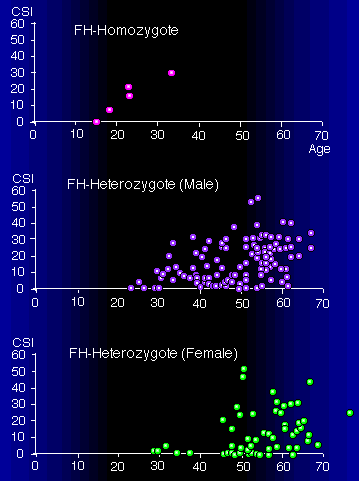
caect-Figure 6
Plots of correlation between age
and coronary stenosis index (CSI) in homozygous(A) and male
and female heterozygotes
Serum cholesterol levels in normal
subjects, heterozygous and homozygous patients with FH showed
distinct trimodal distribution of serum cholesterol levels (caect-fig7.gif
see below) , and the high levels of serum cholesteol were due
to high levels of LDL- and IDL-cholesterol (caect-fig8.gif,see
below). Thus, FH is a disease of abnormal LDL metabolism.
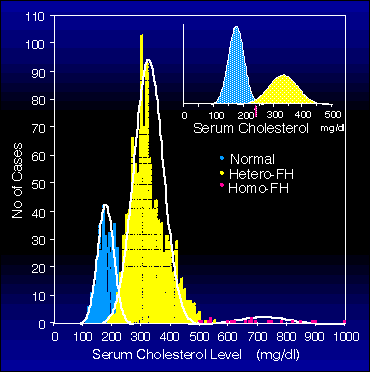
caect-Figure7
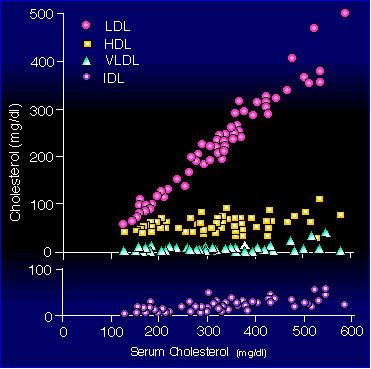
caect-Figure 8
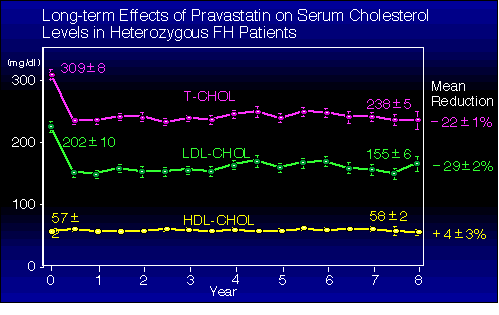
caect-Figure 9
Long-term treatment of FH with
pravastatin was shown in caect-fig9
For the homozygous FH patients who are resistant to most of
cholesterol-lowering drugs, liver transplantation, LDL receptor
gene therapy or LDL-apheresis is indicated. A homozygous patient
(Y.Y.) has been treated by LDL-apheresis using dextran-sulfate
beads column . His xanthomas disappeared soon, and anginal attacks
subsided after the twice a week treatment. LDL-apheresis using
dextran-sulfate cellulose column is an intensive cholesterol-lowering
therapy, and highly effective in removing apolipoprotein B-containing
lipoproteins from plasma. Before and immediately after each
LDL-apheresis, serum cholesterol decreased by 57%, and LDL-cholesterol
by 66% and triglyceride by 74%. In contrast, HDL-cholesterol
decreased by 22% . Forty-three heterozygotes had been treated
by combination of LDL-apheresis and medication, while 87 heterozygotes
had been treated by cholesterol lowering drugs alone for about
6 years15. Compared with drug therapy alone, LDL-apheresis produced
greater reductions of total and LDL-cholesterol levels. On the
analyses of Kaplan-Meier of the coronary events including non-fatal
myocardial infarction, percutaneous transluminal coronary angioplasty,
coronary artery bypass grafting and death of CHD, the rate of
total coronary events was 72% lower in the LDL-apheresis (10%)
than in drug therapy (36%)
Hiroshi Mabuchi, MD., PhD.
The Second Department of Internal Medicine
Kanazawa University School of Medicine
Takara-machi 13-1, Kanazawa 920-8641, Japan
TEL:(76)265-2250, FAX:(76)234-4271,
E-mail: mabuchi@med.kanazawa-u.ac.jpg